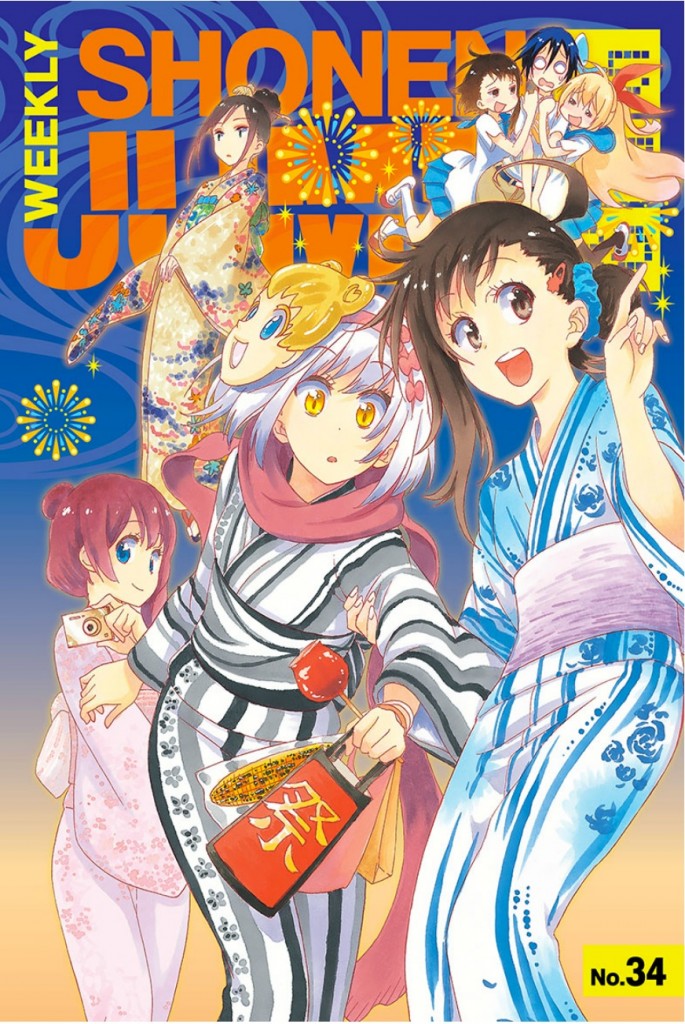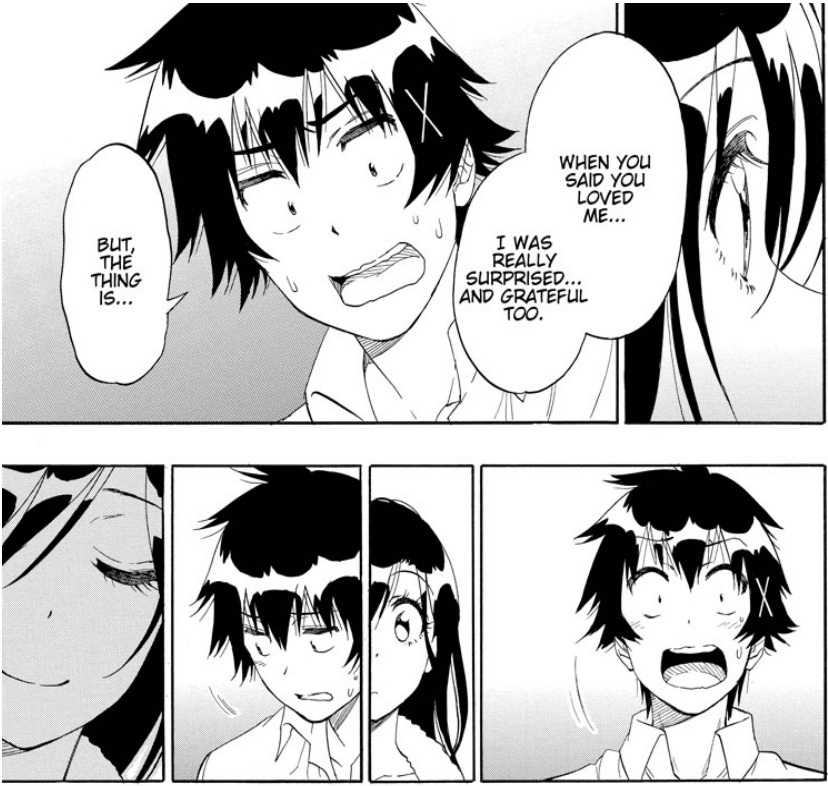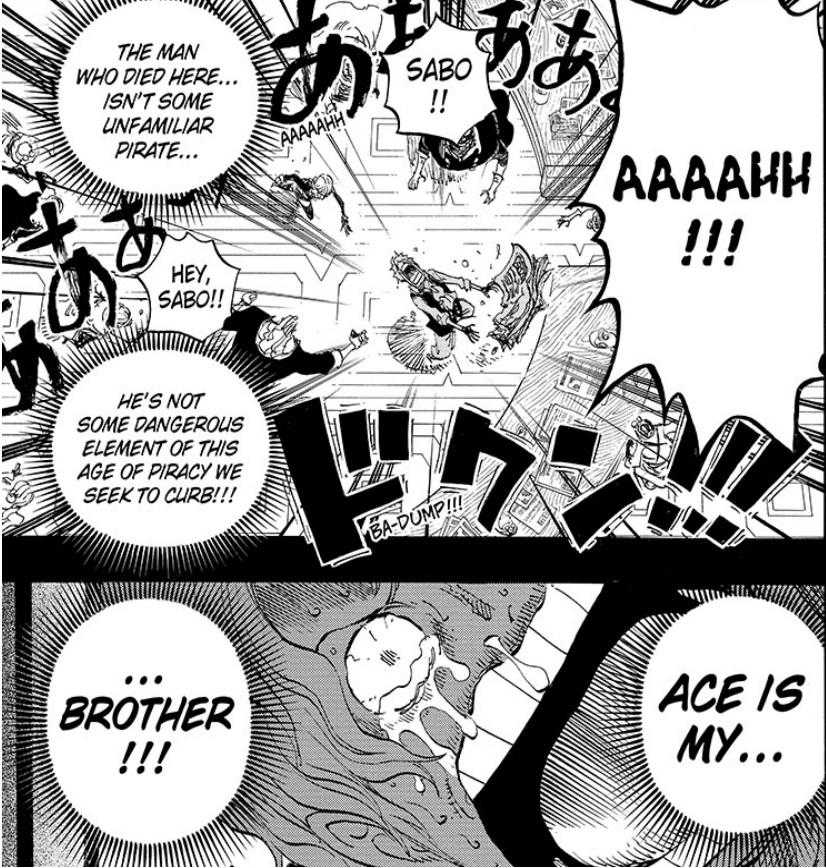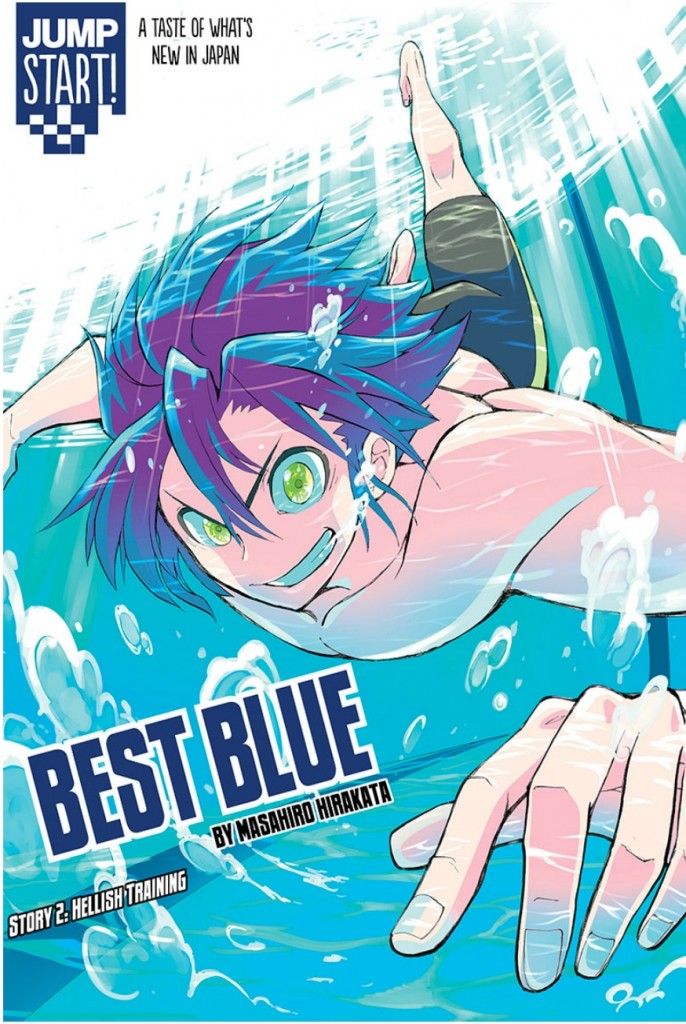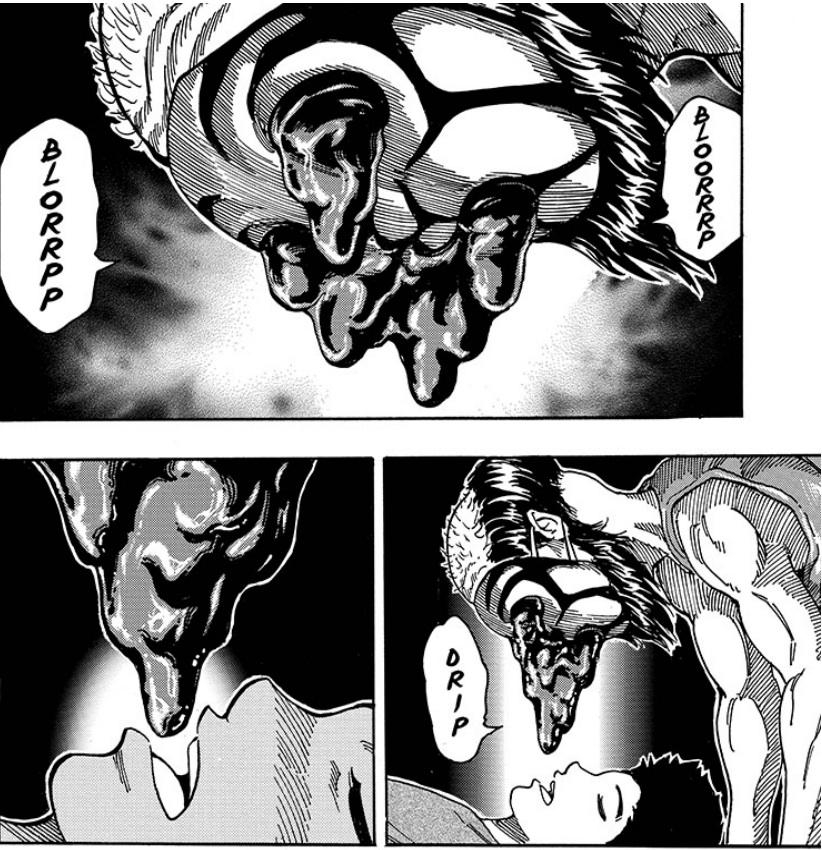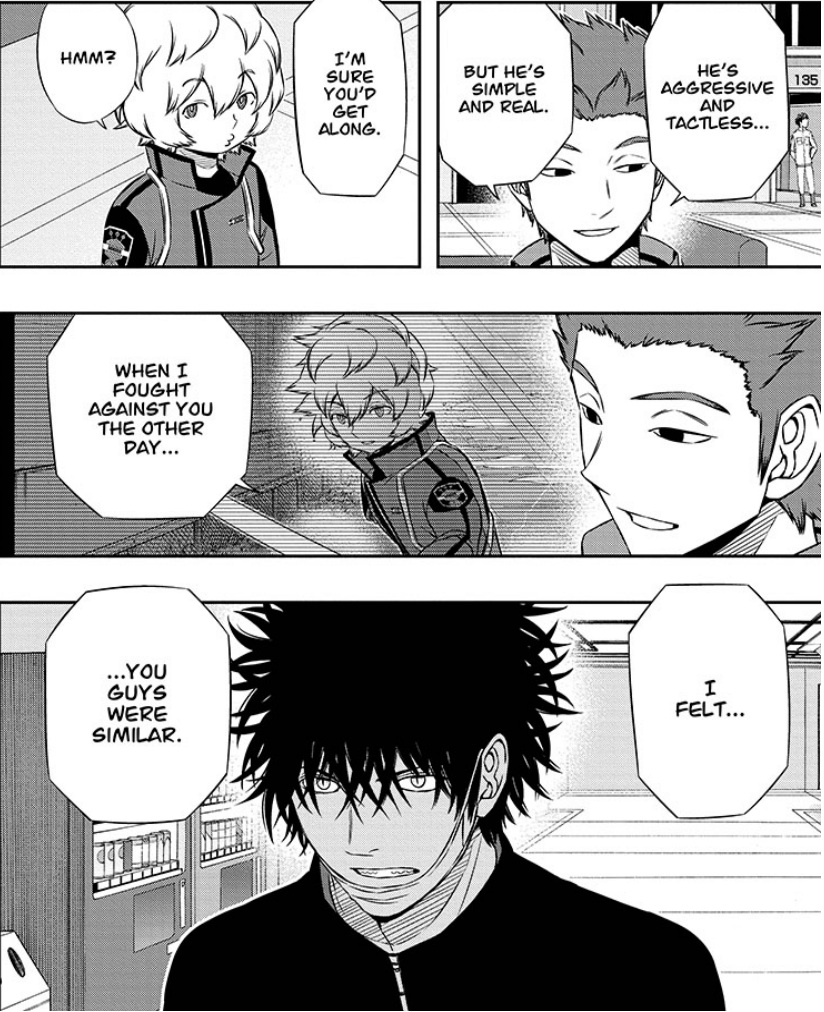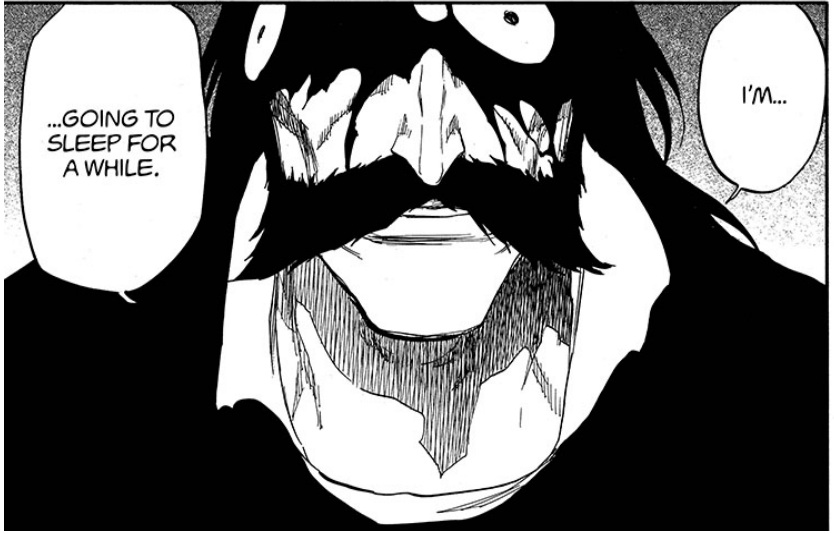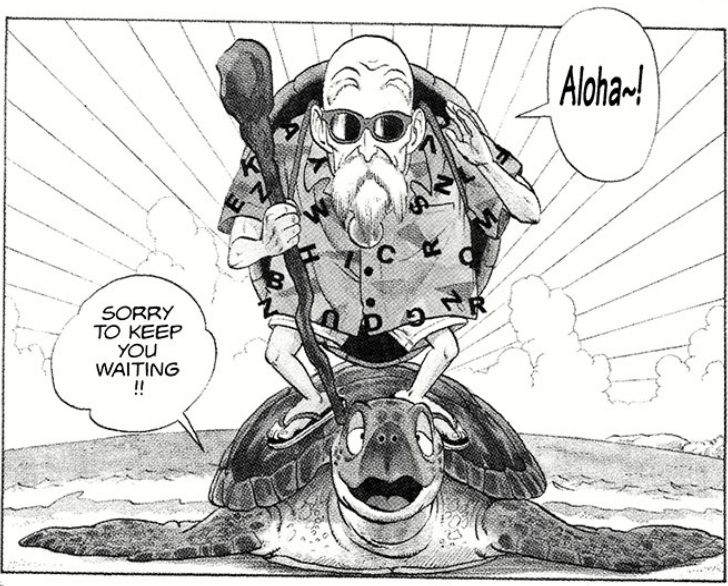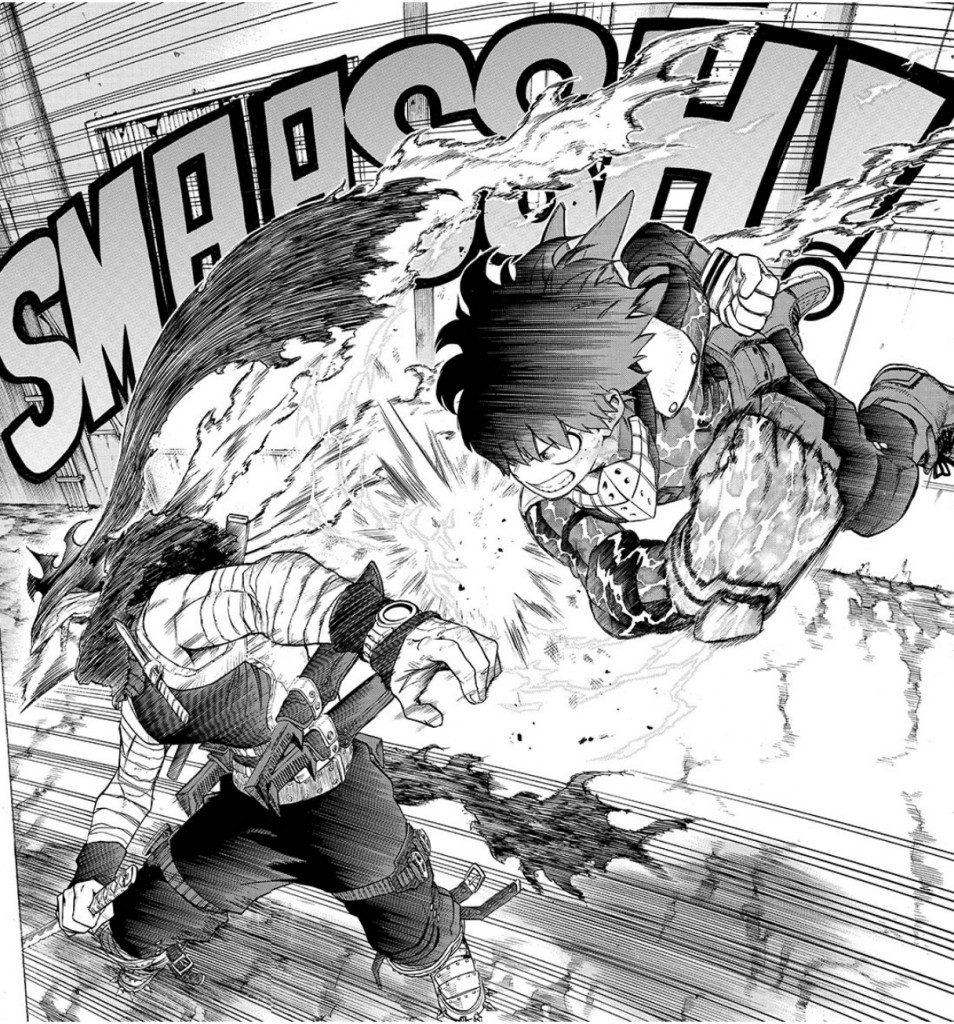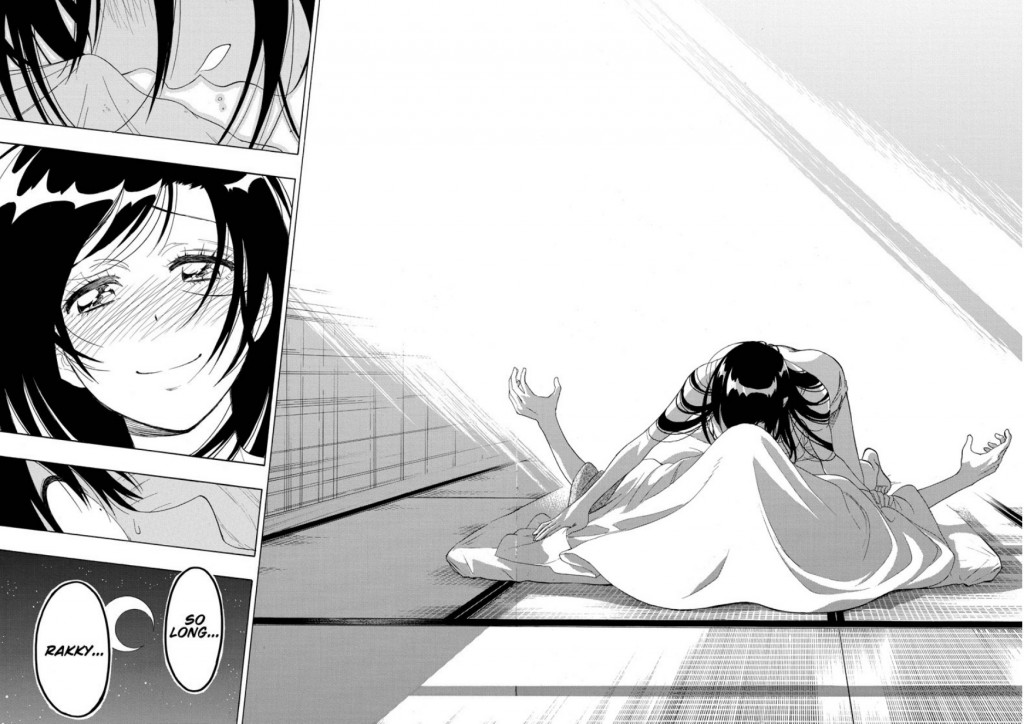07.26
Contrary to what I had said previously, in terms of actual page count this issue wasn’t really that much longer than last week’s. However, the return of Nisekoi and World Trigger has upped the series count to ten, and these are all fairly substantial, so I still had to write a lot more. I certainly don’t mind, as this was a surprising issue in more ways than one. Though that also made it more time-consuming to talk about, which is why I wasn’t able to get this out on Tuesday (on top of dealing with other pesky real-world obligations). I’ll just give fair warning and say in coming weeks, specifically in the fall, you should expect these to come out later in the week (probably on fridays), rather than on Tuesdays like I’d ideally want them out. Reason being that all my classes next semester are between Tuesday and Thursday, and these take more than a day to write, especially since Jump doesn’t come out until around 12:30 in the afternoon most of the time. Might be a but pre-mature to mention this since there’s still a few weeks of summer left, but hey, I needed something to ramble about for the prologue.
On that subject, as I had previously mentioned, Barnes and Noble had a buy 2-get-1 free manga promotion going on all last week. They conveniently forgot to mention in their initial press release that you COULD purchase the stuff online, so I ended up going to the store and unnecessarily more for stuff at store prices. Quite annoying. But hey, they were offering a free Viz manga sampler at the stores, among posters and stuff, which was pretty neat. The only Jump series in it is My Hero Academia, but hey, it’s a free manga sampler. It was worth a flip-though and there were some series that caught my eye to check out sometime in the future. If this write-up had come out earlier, then I would’ve advised you to visit the stores and check out the stuff yourself, but unfortunately that ship has sailed. Oh well, there’s always next time.
Anyways, enough about print manga, let’s talk about some digital! In this week of Jump, a creepy old man tries to throw up in Komatsu’s mouth, Soma and Sadatsuka begin a very dangerous friendship (for those around them), and Raku has to, gasp, make an actual decision in his romantic life!?!?! Who could’ve seen THAT coming! All this and more, After the Jump!
Weekly Shonen Jump: 2015, Issue No. 34
Nisekoi chapter #178 – “Growing Up”
I find it strange that Viz gave the Nisekoi the cover for this week’s issue, but used a picture that doesn’t relate to the contents of this week’s chapter, and features characters that are completely absent in it. I know they choose random pictures when they don’t use the japanese covers, but usually they do a better job of getting a picture that’s at least fitting or general enough to relate to the series in the issue.
I spent a lot of time thinking about what I wanted to say about this chapter. How to best describe what works about it. Because I know that the series’ detractors and pessimists are still skeptical about whether the development given here will stick. Romantic comedy manga are notorious for being dragged out and often repetitive, dedicated to maintaining the status quo for as long as possible. This isn’t anything new; just go all the way back to Nisekoi‘s 80’s Jump equivalent, Kimagure Orange Road, which had arguably more “filler” in it’s story than Nisekoi does (though it did have less characters and had ended 20 chapters shorter than where Nisekoi is now, but I digress). Because these series are often static for long periods of time, people start to get frustrated with them, and many lose interest or turn on them. It doesn’t help if the situations and comedy in the series are standard fare, which Nisekoi, in spite of Komi’s strengths as an artist, often is. So at this point, people are no doubt going to take any semblance of forward plot progression with a grain of salt. If the plot hasn’t moved meaningfully in the last 50 or so chapters, than why should I believe that it’s going to now? It’s not like Nisekoi has lost stream in it’s popularity either; it tends to rank in the middle, which is pretty good considering Jump is chock-full of hits these days, and it had a second season made for it’s anime recently with a third no doubt on the way. This series has enough steam going to run for years more.
As such, I understand why some people are too burned to trust that this series is going places. It’s hard to tell with romantic comedies, especially since the story can end at any time once the characters finally wise up and realize that they love each other. But it’s not this chapter by itself that is moving the story in a new direction. Rather, this is a pivotal installment of a recent string of story arcs that have, slowly and subtly, been shaping the direction of character arcs and relationships in the series, presumably towards it’s endgame. The Chitoge going home storyline, the christmas date with Onodera, the island misadventure with Marika, and now this arranged marriage story arc with Yui; these last few arcs in Nisekoi have noticeably and purposefully focused on Raku being forced to seriously examine his relationships with all his love interests, and develop their characters as well as the underlying story of the locket. All of these arcs have been presented in quick succession since the beginning of this year, and so far the series has not yet devolved into more filler (with the exception of a certain chapter last month that showed Nisekoi at it’s least inspired, but you could consider that one last bit of levity before all this serious stuff hit).
It’s true that the status-quo was not changed in any of these arcs, but that wasn’t their purpose. They served to develop characters and get them to start taking their relationships more seriously. Through the course of these arcs, Raku has had to contemplate just what the women around him mean to him, and exactly who he’s in love with. No, he hasn’t figured it out yet. At least, on the surface. It’s clear that he’s in denial, and that he’s becoming ever more self-aware about it. And as the pressure to make a decision and do right by the feelings of other mounts on him, he recognizes that he has to think about his relationships seriously, and understand how he really feels, and who he really loves. And the final push to get him to accept that came in this chapter. It came because of Yui’s confession.
For the first time, Raku was forced to make a decision about his romantic life under time-sensitive pressure. There was no stalling, and no way out that wouldn’t force him to either commit or end to a relationship. Either he says he loves Yui or marries her, or says he doesn’t and she leaves his life to be married to someone else. Yui made her feelings towards him perfectly clear with no ambiguity. Raku had to think about if he felt the same way, and accept that he just doesn’t, and find a way to break it to her without hurting her feelings. Before, when Shuu asked him whether Chitoge or Onodera more, he was able to weasel his way out of giving genuine answer. None of that was going to fly this time. He had to be honest and direct. He had to finally man up and say “no” to a yes or no question. And he has to live with the consequences of that decision.
Some people feel that the series will cop-out on Yui’s arranged marriage and she’ll still continue to be their teacher. Maybe, but the thing is, that wouldn’t restore things to the status quo. The events of this chapter are irreversible. Yui made the fact that she loved Raku as a man perfectly clear to Raku, and Raku made the fact that he only sees her as a sister-figure perfectly clear to her. They know how the other sees them and feels about them. Yui’s accepted this and has decided to move on. But while she might still be able to treat Raku like a brother, Raku is going to have a harder time treating her like a sister now that he has been forced to think about her in another light. They’ll do their best to continue to treat each other as they had before, but their relationship fundamentally can’t ever be the same as it once was. Especially since Yui kissed Raku at the end of the chapter. Come on; if someone you thought of only as a sister went and did that, you’d be awkward around them for a long time. Raku and Yui have reached a level of intimacy about each other’s feelings that’ll make it hard for them to see each other the same way.
I don’t care for Nisekoi when it’s dealing in traditional romantic comedy harem antics. I’ve seen them done leagues better in more creative comedies, and Nisekoi‘s only strength when it comes to those is it’s art and comedic timing, not cleverness. However, I’ve noticed that Komi does have talent for writing genuinely compelling drama; the storylines involving Shuu’s crush on his teacher and Ruri’s visit to her grandfather being two of the series’ strongest examples. As this year has gone on, I’ve noticed that Komi has finally decided to apply his strengths to serious arcs involving the main characters, and move this story and these characters closer to making decisions about their relationships and come to mutual understandings. This chapter provides a resolution as status-quo changing as they come, and a pivotal moment in Raku’s character arc. How the consequences of Yui’s departure will affect Chitoge, Onodera, Tsumugi, and Marika remain to be seen, but considering Yui’s declaration to Chitoge, this will likely force them to step up their game and make similarly tough choices in admitting their feelings as she did. Nisekoi is at it’s best when it’s focused on it’s story and characters and does something meaningful with them, and with the momentum it’s built throughout the year in this regard, I feel confident in expecting that we’ll see the story continue to move forward as the year continues and ends, with little or no filler in between. The carefree, irresponsible adolescence of Nisekoi is over. It’s time to grow up.
You know what, though? Beyond even all of that, this was just an emotionally resonant chapter. After spending the chapter focusing on Raku dealing with his doubts and worries about what to say to Yui, and how she’ll respond, she comes in to his room, lies next to him in bed, and both he and the reader learn more intimately about her feelings. She talks about what Raku meant to her when she was a child, and her own self-doubts as to whether she really loved Raku or was just clinging to the only family she had. In confessing her feelings, however, she has realized that both those feelings were true, and while she has to let go of one, she doesn’t regret it, because it’s helped her to grow. And, in an act to finally give closure to those lingering feelings, she throws a sheet over Raku’s face, and gives him a kiss through it goodbye. It’s a powerful, moving scene; a more effective and well put-together moment of emotional closure than expected for who has arguably been one of the most underutilized of Raku’s love interests. I take this chapter as a key moment for this series on a contextual level, but even on it’s own, it works as a piece of well-written and touching romantic drama. And as a fan of well-written romantic drama, I couldn’t be more impressed or pleased. After a long stretch of indifference, Nisekoi has become a series I genuinely look forward to and am excited to read each week, and I can’t wait to see where the series goes from here.
One Piece chapter #794 – “Sabo’s Adventure”
One of the most important developments of this arc was the revelation that Sabo was alive. It was twist that should’ve been an incredibly emotional and memorable moment, but was executed in such a underwhelming, ho-hum manner that it didn’t shock, wow, or resonate. There’s a couple of reasons why the scene of Sabo’s reveal wasn’t very impressive. It was a moment that wasn’t separated as special within the chaos and confusion of the arc. There was no build up to it within the arc before Sabo met with Luffy again; possibly the biggest error of all, since the impact should’ve come from Luffy’s emotional response to knowing his brother was alive at the same time as the reader. Instead, Sabo meeting with Luffy in obscured guise was the only set-up for his reveal, so everyone could guess and call it when Oda finally went “yeah, Sabo’s alive!” The moment wasn’t a surprise, it wasn’t very memorable, and there was little emotion to the fact Luffy had reunited with him and he ate Ace’s devil fruit. It was a total misstep of a character reveal about on par, dare I say it, the return of Grimmjow in Bleach. Sure, that’s an arguably less effective twist, but only because that series dragged it out so much that people stopped caring. Sabo’s reveal is way more consequential and important to OP than Grimmjow was to Bleach, and the fact that it didn’t resonate any stronger is a huge blemish on OP’s overall narrative.
Because the reveal of Sabo was lost in the chaos of the rest of the Dressora arc, questions about how Sabo survived, where he’s been, and why he hadn’t reunited with Luffy and Ace sooner was left unaddressed. This chapter sees Oda trying to answer all these lingering plot threads, and while the result makes sense, it’s also annoying cliche and predictable. Sabo survived because Dragon saved him. Wow, what a shocker! Sabo suffered amnesia for a decade before Ace’s death jogged his memory back. How convenient! To be fair, the two pages building up how Ace’s death flooded Sabo with memories, causing him to suffer a mental breakdown, were very well done and carried some some palpable emotion to it. The circumstances are just so blasé, though. The memory-loss stuff is the most convenient and basic way to hand-wave why Sabo didn’t bother showing up until now; I’d have expected Oda to give him more of an interesting backstory, more of interest to what he’s done in these past few years. But apparently, nothing big or momentous happened to him between losing his memory and getting it back. There’s nothing added to his character, no new threads revealed or elements to his character explored. It’s just as wasteful as the mishandling of his reveal was.
The second half of the chapter is devoted to expanding on Sabo’s reunion with Luffy…and it’s shockingly somehow makes it less emotional and impressive that it originally was. It also doesn’t say or do anything that justifies the pages spent on it; the point was that Luffy recognized Sabo and agreed to let him have the Flame-Flame fruit. We already inferred that from how events played out in the arc, so what was the point of showing this extended sequence long after the fact? If this scene had occurred in it’s proper place, after proper build up to Sabo’s return through the course of the arc, it might have worked. If it had been shown earlier, around the time Sabo ate the fruit, it might have worked. But it doesn’t work now that the arc is over with and the fact that Sabo’s back is old-hat. There was no need and there was no point, and that bugs me, because usually there’s nothing in a OP chapter, stuffed as they are these days, that has no point. Oda tends to pack this chapter with a lot going on that moves the story forward. This chapter doesn’t move the story forward. All this chapter accomplishes is filling in some gaps about where Sabo’s been, and all that amounts to is uneventful information that could’ve been spent in only a couple of pages rather than a full chapter. Honestly, it feels like filler.
This isn’t the first time I’ve felt that way about a recent OP chapter; the chapter that was literally just spent on Gyats announcing that Luffy beat Doflamingo seemed equally wasteful. It’s not like either of those chapters are necessarily bad, and there are moments in this chapter that sorta work. But the combination of giving Sabo and uninteresting backstory and explanation for his absence in the story, and the repetition of previously established information really annoys me. Probably more so because last week I was so excited to see what will come next for the series, and the horizons beyond Dressrosa, but I still don’t think this chapter was as well-done as it could’ve been and necessary in the grand scheme of things. It’s a disappointing stumble for the series’ forward momentum and my excitement for it, but at the same time, I recognize that Oda might’ve felt obligated to give Sabo his own chapter in recognition of his newfound popularity and importance. And with that obligation out of the way, I hope to see the series take a step forward next week, and build up the next big arc of One Piece. One that I hope will be more fulfilling and consistent than the Dressrosa arc has been as a whole.
Black Clover chapter #22 – “Assembly at the Royal Capital”
Mmm, not really a fan of the romantic triangle brewing between Asta, Noelle, and Mimosa. It’s not like I can’t see why the latter two might have grown feelings for him, especially Noelle. Dumb as he might be, he’s passionate, kind, and loyal, and the fact he does have a pretty ripped bod for a kid his stature doesn’t hurt things too. I’m just not big on romantic subplots in battle shonen, especially ones that don’t gradually start and develop naturally after a good period of time, rather than be shoved near the start of a series like this. Few writers in the genre can write it well and most of the time it amounts to just annoying and irritating distractions to the story or a degradation of female protagonists’ character arcs to simply revolve around their status as love interests. I don’t know how Tabata will handle any future romantic subplots, but I’m hoping they won’t be the focus of Noelle and Mimosa’s character arcs in the future.
That’s such a small aspect of the chapter, in any case. The core involves Asta and Yuno meeting the Wizard King, who inspires their resolve and introduces them to potential new rivals in their quest for the throne. I liked the key takeaway of the chapter; the advice the Wizard King gives to Asta and Yuno about what quality the Wizard King should have. Rather than it be something cliché and lame like heart and believing or yourself or some bullshit, the Wizard King tells them the single most important thing in order to take his position is results, results, results. They have to show they are capable of accomplishing notable feats and build a reputation for themselves if they want a chance at it, and the one who shows the most merit will be the one who inherits the position. I like that; that’s a respectable, sensible message that actually applies to the real-world. You don’t get anywhere unless you work hard and show that you’re skilled at your craft, and people recognize and acknowledge your abilities. Fuck friendship; results is where it’s at!
Beyond that, there are a few details about Asta and Yuno’s new abilities expanded on here that I’m grateful for. One is that Asta’s new, slender sword is something that he can summon from his book, and it actually absorbs magical power. The reason Asta is able to wield it is precisely because he has no magic to begin with. I fear it might end up being overpowered if no checks are placed on it, but it makes for a cool new weapon. Yuno’s power is more interesting, as apparently the fairy-thing that helped him defeat Mars was Sylph, a wind spirit who’s a part of a group of magical beings called the four great attributes. We don’t know anything more about these creatures, but it’s a development that I’m looking forward to see expanded upon. Especially since Asta will probably ally with a great attribute of his own. With the introduction of new rivals and powers to be fleshed out, there’s a lot to be intrigued about in Black Clover right now. The series’ first major arc was solid enough, but I’m curious to see how the series will evolve from here.
My Hero Academia chapter #51 – “No, Knock It Off, Ida”
Wow, Hand-Face guy really has no clue, does he? I discussed last week how he and Stain have fundamentally different goals in killing heroes; Stain wants to weed out the pretenders and Hand-Face wants anarchy. Turns out, though, that Hand-Face isn’t even a pure anarchic who wants destruction for destruction’s sake. Nah, turns out he’s just out for attention. He wants to make a name for himself; to be established as someone to be feared, and through that fear, respected. He claims that he disagrees with Stain’s methodology, but perhaps he’s just jealous of him. Stain’s accomplished more than he ever has and has earned the reputation of being a hero-killer. People know him, and people are afraid of him. But no one gives a shit about Hand-Face guy. He didn’t team up with him because they shared a similar task; rather, he wanted to compete with him on the same stage. He wants to use his Nomu to cause more destruction and death than Stain, overshadowing him in popular consciousness. Deep down, he’s not a villain because he has a legitimate ideological motive, but rather, because he wants fame and notoriety.
That’s all well and good for Hand-Face guy, but even if his Nomu kill more people he still won’t beat Stain because Stain isn’t competing with him and doesn’t give a shit about whether he’s infamous or not. Stain is motivated by his ideology; he believes that heroes should be truly virtuous and selfless, and in an age where heroes have become a commercialized part of every day life, he’s become irritated and disillusioned with those who take up the mantle. Stain goes after and kills heroes who don’t reflect his ideal image of what a hero should be; by getting rid of the posers, he hopes to inspire the return of true heroism. He has a warped perception of what a hero should be, in that he seems intolerant of the humanistic aspect of them. He doesn’t tolerate any form of weakness, both in strength or morality, ignoring the fact that heroes are still human beings at the end of the day and have the same weaknesses as any person would. It’s the fact that in spite of those adversities, these people are able to do right by others and fight for the greater good that makes them true heroes, but Stain clearly disagrees. That’s probably why he attacked Ingenium, despite his respectable reputation; he might have done a lot of good, but he still didn’t perfectly embody what a hero is to Stain. Stain’s ideology is strict and twisted to the point that very few heroes actually meet his standards, and a good chunk of the people he’ll target if he continues to run loose will probably be people like Ingenium more so than the truly corrupt. In short, Stain is the worst kind of psychopath; one who is convinced that everything he does is right and for the greater good of the world.
I really, really wish we could’ve had more of a fight and discussion between Stain and Ida. Both characters bring up great points about the other, Stain noting Ida’s selfishness in seeking revenge being an unheroic trait, and Ida’s that Stain still hurt another human being who was doing a lot of good for his community. It would’ve been nice to dig deeper into the characters, and have Ida come to a realization that his actions were misguided and uncharacteristic for the person and hero he wants to be, but I’m sure they’ll be more development on that front in subsequent chapters. For the moment, though, Midoriya’s come charging in to take on Stain himself. He hasn’t mastered One For All enough to be able to take him down, but he should be able to save Ida’s life. Though, considering the foreshadowing of previous chapters, Ida might still suffer the consequences of his actions through other means.
Rather than Midoriya fending off Stain by himself, I have a feeling that Endeavor will be thrown into the mix and take on Stain himself in a chapter or two, considering part of this chapter builds up his arrival. I hope that happens, because that would be an incredibly fascinating fight. Endeavor is a vain, power-hungry narcissist who prioritizes his reputation and legacy over helping others; he represents everything Stain absolutely loathes about modern day heroes and is trying to purge. Even though Stain is probably not as powerful as Endeavor, the clash of powers and ideals between the two would be an undoubtedly heated conflict in more ways than one, and the possibility excites me. Of course, this is all conjecture. Next week Midoriya’s taking on Stain, and if we receive the same level of intensity and exciting visuals that this chapter offered, then we’re bound to see one hell of a fight.
Best Blue chapter #2 – “Hellish Training”
Sometimes a simple story can be the most effective, even if that simple story feels a bit familiar. This chapter of Best Blue doesn’t do anything necessarily unique in terms of the story it tells. Numerous sports manga have done the hardass trainer putting his trainee under a grueling regimen, but it turns out he truly has his best interests at heart and that inspires the trainee to work even harder. Best Blue doesn’t do this any differently, but it does it well. It knows just the right panels to emphasize, the right places to get a laugh, and the right moments to emphasize for emotional impact. We don’t learn anything necessarily new about either Aono or Kagura in the chapter, but they are presented as likable and their dialogue, thoughts, and actions are understandable if not exactly realistic. You get a good sense of the pressure and difficulty the training is having on Aono as much as you do the dedication Kagura has to making him into a great swimmer. The beats of the chapter are predictable, but it never feels boring. I saw the ending coming a mile away, but I still found it rather sweet and inspiring. While it’s basic at it’s core, it’s still effective as a whole.
In the grand scheme of things, this chapter may have been unnecessary, and the series could’ve just skipped ahead to when Aono entered High School. However, it’s purposeful in expanding on the connection between these characters and what they see in each other. Kagura is Aono’s idol; he respects and looks up to him as the kind of swimmer he wants to be. Kagura sees in Aono his older self, and because of that, he’s dedicated to giving Aono all the opportunities and skills he can offer him in order to help him become a great swimmer. He remembers the excitement and elation he felt when all the hard work and training he put into his passion paid off, and he wants Aono to experience that one day as well. There’s a bond of trust and camaraderie between the two that feels a bit more personal than a lot of master/student relationships usually start out as, and it’s clear that the relationship between these two is what will drive the manga forward. While the series is still has a ways to go in terms of defining a distinct identity for itself, I look forward to seeing it mature as a story as much as Kagura is looking forward to seeing Aono grow as a swimmer.
Toriko chapter #331 – “The Odd Mask!!”
So, it turns out Love really has had her soul switched with a spirit from the Back Channel, who is currently inhabiting her body. But it seems that isn’t necessarily a bad thing, because the gang has to submit to some soul-switching in order to join some mysterious “project.” Though I say that, considering the shadiness of the business and the fact lil’ Chaco’s gotten his soul outright stolen, I suspect foul play is afoot. Blue Grill’s got a dark side, both metaphorically and literally.
As I suspected, Komatsu’s role in this arc is going to be separate from the rest of the chefs. While they compete against the Ten-Shell chefs, he’ll be trying to rescue Chaco and uncover and expose the dark underbelly of Blue Grill. We haven’t had a two-faced town kind of arc in Toriko yet (whereas most One Piece arcs seem to amount to this), and the fact that Komatsu is presumably going solo against a big conspiracy is really cool. Komatsu hasn’t had this kind of focus in a long time, and the fact that he’s not a fighter will make the suspense and danger facing him all the greater. With all the ghosts and creepy masked people and stuff, I’m expecting that this arc is going to be characterized by A LOT of eerie horror.
And boy oh boy, was this chapter eerie as fuck! Even out of context, that above image should make you go “WTF?” From the very beginning when Komatsu follows Chaco to his home in the slums, to the very end with the revelation that Chaco’s been spirited away to have his soul sold, there’s a pervasive uncomfortableness in this chapter, one that climaxes with Komatsu’s probably meaningful dream sequence. It’s pretty clear that something is wrong about Blue Grill. The circumstances surrounding the employment of Chaco’s mom, why Lala had her soul switched, the reasons why the chefs have to compete in a cooking test and then participate in “The Project”…it’s all extremely suspicious. This arc is building up one hell of a conspiracy, and I can’t wait to see it explored and exposed.
World Trigger chapter #109 – “Masata Kageura”
Well, it turns out I was only partially on the mark about Kagegura’s Side Effect allowing him to read minds. Rather, it’s something they’ve labeled as “emotional perception.” He doesn’t know exactly what’s in people’s minds, but he can interpret how they feel about him. Emotions have different sensations that he can physically feel, and negative emotions positively sting. When people think ill of him too much, he gets irritated, and lashes out, which causes some problems and injuries for those foolish enough to get on his bad side. Of course, it also doesn’t do him any favors in terms of his career path, as he’s frequently chastised and punished for his outbursts. Kagegura’s as strong as any A-Class, but he’s been demoted to B, and is in the process of working his way back to the top.
Last week I mentioned that Kagegura and Yuma seemed to be have interesting parallels, and this chapter hammers that home. Like Yuma, Kagegura keeps his real emotions under a facade, though in contrast to Yuma’s carefree attitude, Kagegura is irritable. Both of them have powers that let them discover the true natures of people under their own guises; Yuma can see when people are lying to him, and Kagegura can feel how people think of them. Both have A-Class level skill and strength, but are working to help their teammates progress through the ranks. Ko is right; they’ve got a lot in common. Whether it’ll be a friendship or a rivalry that blossoms through their common ground remains to be seen, but it’ll make the inevitable fight between them possibly the most even-matched Yuma’s ever had, and possibly his most interesting as well.
If Kagegura seems like he should be higher ranked, Tachikawa Squad’s Yuiga seems like he should be way lower. Seemingly the butt-monkey of his team, he’s apparently the weakest among the A-Class as well, making it a bit odd that he’s a member of it’s strongest team. But he’s clearly a character with a lot more to him than meets the eye, considering that Osamu has to take him on a beat him 100 times in order to learn composite shots from Izumi. Osamu’s been told to focus on breaking down his enemies’ defenses as his means of scoring points by himself, and that’s what Izumi seems to want to test him on before he lets him evolve his skills to the next level. So my guess is that Izumi might be a weak attacker, but he’s one skilled ass defender. One who’s extremely hard to get points off of. If that’s his schtick, then you better believe Osamu’s got his work cut out for him. 100 wins already doesn’t sound easy, but it’ll probably be even harder than he currently realizes.
Bleach chapter #635 – “Hooded Enigma”
I could make an easy “Bleach is boring as shit” joke out of that image, but to this chapter’s credit, it did have a bunch of stuff going on in it. Stupid, head-bashingly asinine stuff, mind you, but hey, that’s still better than padded fluff. Now, remember last week how I commented that it was kind of dumb that Bazz B was built up as an important anti-villain when his backstory and fight with Jugo served only to emphasize the latter’s character and diminish his relevance? Which made his character thoroughly pointless to invest in or care about? Thing is with Bazz B, while he himself wasn’t as important as his screen-time suggested he would be, his heel-turn and fight with Jugo was at least purposeful in developing the latter’s character and moved the story forward. Now, as for the other quincies who were out for Ywach’s head, Lillioto and Giselle? Guess what – they’ve been utterly curbstomped by Ywach! In a battle we didn’t see, and didn’t do anything that added to the story! So…WHAT. WAS. THE. POINT. KUBO? Why the hell did you bother having these character’s survive Ywach’s genocide if you weren’t going to do anything with them? Three pages. You only show the tail end of their fight with Ywach, and it’s three fucking pages that starts out with a dumb ironic commentary from Lillioto. Even Ywach was like “Welp, that was sure filler. Imma go back to sleep/twiddle my thumbs until Ichigo finally shows up now.” There was nothing gained from having those characters survive. There was absolutely no point to building up their revenge on Ywach. The only Quincy who really needed to survive was Bazz B, because he’s the only one who’s heel-turn amounted to anything resembling substance. Kubo’s stuffed this series with so many characters he just doesn’t know what to do with them, so pretty much every plot thread involving a character that isn’t Ichigo ultimately ends up being an absolute waste of time.
Oh, but Kubo doesn’t just give us one example of how he wastes his characters in this chapter! Ohhhhhh no, he has a lot of work to do to dwindle the numbers down so that Ichigo can fight Ywach mano y mano with no help whatsoever. Like Grimmjow. Remember Grimmjow? Remember how Kubo teased his return for like three years and when he was finally revealed that, yes, “he’s back!”, it was the most underwhelming shit ever? But hey, at least we might get a cool fight out of-NOPE! Ask Le Nakk Le Stupid Name knocked him out with poison like a punk. …Wow. Just…wow. Grimmjow’s return was so worth it, amirite? HAHAHA…fuck you Kubo. Seriously, I didn’t give a shit about Grimmjow even back during the Hueco Mundo arc, but he clearly had fans who wanted to see him get into one last badass brawl. Sure, I know he’s probably going to bounce back from this poisoning and return to the fight, but to immediately have his first fight since his return be resolved with him losing, by way of getting poisoned from an enemy who just ran away from him the entire time, is just insulting. Grimmjow might not deserve better, but his fans sure do.
And it’s not just Grimmjow who’s getting the shaft, it’s…well, pretty much everyone. Even the villains. Like, Thor-expy guy doesn’t have anyone to fight and yells bemoaning the fact. It’d be hilarious if no one bothers fighting him until Ywach is already beat. Meanwhile, all the ancillary Soul Reapers are getting picked off one-by-one by sniper dude because people keep falling behind the rest of the group. Why nobody seems to notice or care that their comrades are missing is suspect…but then again, this is the fucking Gotei 13, the most incompetent military organization ever conceived in a shonen series, so I guess it’s par for the course. So of course sniper dude takes out Hisagi and we’re supposed to go “oh no, not HISAGI!” You know, the guy who was really popular with fangirls for some reason so he had an inexplicably expanded role in the Fake Karakura arc and ended up killing Tosen? Yeah, I dunno, could you maybe choose a different punching bag? Hisagi’s already got screwed so many times this arc he’s basically become the series’ Yamcha. Oh wait no, sorry, that’s still Chad. So I guess I’d have to call him…the Tenshinhan? Nah, even though he become increasingly irrelevant, Tenshinhan at least had his cool moments all the way up to the Buu saga. He still had some dignity to him even as Super Buu one-shotted him. Hisagi? He literally got mind-controlled by the power of love from a fat hippie with heart-shaped shades and a stupid beard. There’s just no bouncing back into relevancy after that. Still, the fact that Kubo took a character that was actually developed and had a major role in defeating one of the series’ major villains and turned him into someone who only exists in order to show how tough his villains are is super dumb. There are no cool characters in Bleach anymore; just pieces of meat to be hacked away at for Kubo’s pleasure, and the reader’s disgust.
And so the chapter ends with Kenpachi’s arm getting crushed by another baddie. Kenpachi, the guy who was built up to be one of Soul Society’s most powerful and important assets in this war, has already been crippled. Again. Oh god, could this fight possibly end up as bad as the one with Gremmy? No, Mayuri is with him, so chances are Kenpachi is going to get shafted for no reason so Mayuri’s bullshit can win the fight just like how all Mayuri fights go. Teamwork be dammed, the man has science! So yeah, I already know how this fight’s going to do, so hopefully it gets over with quickly, Kubo culls the herd, and we start focusing on stuff that actually matters again. Because let’s face it; most of the characters in Bleach exist solely to pad out the series with fights, which is why Kubo treats them as so disposable. The characters themselves don’t matter, so much as how “cool” their powers are and how useful they are in providing “cool” fights. It’s too bad that Kubo can’t be bothered to actually give them good ones.
Food Wars! Shokugeki no Soma chapter #127 – “Moonlight Whispers”
Considering how both Soma and Sadatsuka take pleasure in testing out their bizarre concoctions on poor unsuspecting victims, it’s a shocker that they hadn’t met and became friends sooner. Regardless, a magnificently malevolent friendship has now been born, and I can’t wait to the consequences of it after their inevitable team-up.
Turns out I was partially right about Soma’s scheme! Man, I was partially right about a lot of things this week. Go me! Anyway, Soma’s been hauling his cart around the campus to sell his buns like I suspected. Except he’s not actually selling them so much as giving them away; it’s a free promotion and taste-testing deal. He can raise interest in his stand from potential repeat customers and learn what kinds of food to cater to specific tastes. Thanks to suggestions, Soma came up with a second entree for customers who’d rather eat something lighter – a thin-cut noodle dish, which helped him sell a lot more tickets than he had the day before. However, it seems that this strategy is still not enough. Soma’s pork buns are kind of an abstract food in japanese public consciousness. In that, nobody’s knows how they’d like it or what they’d taste like until they tried one. But Kuga’s sichuan cooking is much more common and easy to get and idea of, taste-wise. So in order to truly compete, Soma needs to think up a dish that has a lot of visual impact and is easy to understand.
This is the problem the Shiomi Seminar is facing too. So far, Alice has been thinking up of flashy, extravagant things they could make. She prioritized her creative impulse to experiment rather than considering the needs of her customers. But Hayama’s pointed out that their customer base in on the cheap end, and that something so pricey and complex isn’t something they’d want. Much like Soma, Alice and co. have to think up a dish that properly suits their customers needs – something that is simple, recognizable, and affordable – if they hope to compete.
While the Shiomi Seminar is still figuring what dish they should make, Soma’s realized he needs to go back to square one and take Kuga on his own turf – Mappo Tofu. Erina might’ve said that his wasn’t on the level of Kuga’s before, but thing about the Yukihara-style of cooking is that it’s always evolving, and Soma’s figured out just how to take his take on the dish to the next level. He’s going to be losing sleep over perfecting it, and I’m going to losing sleep wondering what he’s going to try. Food Wars! always knows just how to spice up an arc, and it’s cliffhangers are unfailingly irresistible. Every week I say the same thing to myself about this series – next week can’t come soon enough.
Oh, and every bit with Sadatsuka with just amazing in this chapter. I was seriously tempted to post pics of all of them and put ’em up…but then I’d just be transplanting the entire chapter, pretty much.
Dragon Ball chapter #3 – “Sea Monkeys”
With the lead characters and the basic details of the world established, Toriyama takes the next step in developing them. Part of this involves expanding on Goku’s naivety and moral compass; really, the simplicity of his character. His misunderstanding of honorifics and belief that Bulma had turned into a turtle are very silly jokes, but subconsciously inform the reader that Goku isn’t well educated and thinks about things in a very literal and straightforward way. We see that he’s a pretty nice fellow who trusts people easy and gladly helps those in need, since he doesn’t hesitate to offer Turtle help when he finds out he needs to return to the sea. The encounter with the Bear-thief shows he’s pretty no-nonsense and fearless, and uses his speed and wit to quickly subdue opponents. Through the quick succession of these moments in the chapter, we get an even more rounded sense of who Goku is as a person, and with the information and background we’ve learned about him in the previous two chapters, his character has been completely established and accessible for the reader to invest in.
One of the most notable aspects shown about Goku’s character in this chapter is the idea that he’s not a really a goody two-shoes hero. Even though he saves Turtle, he also seriously consider eating him after hearing that his meat might taste good, only changing his mind when Turtle manages to convince him otherwise. This is a small, but revealing little detail. True, Turtle is, well, a turtle, but he’s also a sentient creature that Goku had befriended. While Goku might be quick to help people, but he is also quicker to submit to his whims and personal interests, prioritizing them over the safety and best interests of those around him. It’s an aspect to his character that becomes more consequential and damaging in later arcs where people’s lives and the fate of the earth are on the line, and it’s neat to see the seeds of it shown here.
While the chapter is mainly useful in characterizing Goku, it does also begin to expand the world of the series a bit more with the introduction of Master Roshi at the tail end. It’s unclear whether Toriyama originally intended Roshi to be as major a character in the series as he ended up being, but in of himself, his existence presents a sense of randomness to the world and throws the readers expectations into wack. After all, I don’t think any first-time readers of the series had expected Turtle’s “reward” to be an old-man. Toriyama sprinkles in these surprises to keep the reader engaged, but also keep what he can do with the world loose and flexible to fit his interests. This versatility is how the series was able to change into something radically different from it’s beginning to it’s end, and plays a large part in how Toriyama was able to keep it fresh for over a decade. This is a light chapter for analysis, but it provokes a lot of interesting meta-textual musings looking at it from a retrospective perspective. If the series was being run as a Jump Start today, this would have been the last preview chapter, and just based on what I had seen from the first three chapters, I definitely would’ve voted it high up in the survey.
Final Thoughts:
Not quite as strong an issue as last week as a whole, since One Piece was lame and Bleach was, well, Bleach, but the chapters that were good were really good, many really great. Nisekoi and World Trigger made good on welcome returns, and Food Wars! and My Hero Academia have some serious momentum going. If I had to define a theme between the chapters in the issue, it’s maturity. Many chapters in this issue see a character who’s about to embrace the next step of their personal growth, be it Yui being ready to move on from Raku, to Ida getting a wake-up call from Stain about vigilantism versus heroism. They don’t have a much deeper connection between them than that, but it’s still something to consider. Otherwise, these chapters are about possibilities; both the potential that can be reached by hard work and dedication, the dangers that lurk in unfamiliar surroundings, and the depths to which Bleach will sink in failing to provide half-way decent entertainment. But enough postulating about tenuous thematic connections that may or may not exist. Let’s review what the cream of the crop of this issue was, shall we?…
Best Manga of the Week:
1. Nisekoi – With strong character development, a long welcome and irreversible shake-up to the status-quo, and a genuinely moving emotional payoff, Nisekoi had the best chapter of the issue, hands down. People might be skeptical that the series is going places after it had been stuck in a rut for so long, but I’ve noticed the signs and I’ve played this game with long-running romance manga before. I have a good feeling that Nisekoi isn’t about to take another detour, but go all the way in a single burst. And right now, I’m enjoying the ride.
2. Food Wars! – Excellent character bits and a turn of events in Soma’s strategy to outsell Kuga, with Alice getting some interesting character growth as well in the b-story. Not to mention that Sadatsuka was an absolutel scene-stealer with all her moments in this chapter, and the newfound friendship she has with Soma excites me with all it’s macabre possibilities. It might not have the flash of a shokugeki chapter, but it’s got a whole lot of substance to rival one in entertainment value. A winner on all fronts.
3. My Hero Academia – While I was hoping for just a little more of a fight and discussion between Ida and Stain, the ideas expressed in the chapter are still a ton of fun to think about and apply to each characters’ motivations and potential arcs, and Stain continues to be a brilliantly-construed and fascinating villain. The art and action in this chapter also delivered just the right amount of thrill and hype, getting me pumped to see Midoriya take on Stain with Ida in next week’s installment.
4. Toriko – Enigmatic, unsettling, and at one point disturbing, this was one heck of a chapter to characterize this arc and the dark side of the cooking paradise of Blue Grill. The conspiracy laid out here is full of sinister mystery, and I’m extremely excited by the potential of Komatsu tackling it on his own as his fellow chefs engage in a cooking showdown like no other with the 10-Shell chefs. No chapter in this issue left me more intrigued by what might happen next than Toriko‘s did, and it’s a promising sign for an increasingly promising arc.
Line(s) of the Week:
Kagura: “Make sure he doesn’t slack off on training and studying. To ward off all the bad omens, throw away all the porn under his bed.”
– Best Blue
Panel(s) of the Week:
Page(s) of the Week:
And that does it for this week’s issue! Hopefully the next one will be up on time. Well, until then, try not to get pelted by poison balls, eaten by anthropomorphic bears, or get your soul sold to spooky masked men, and I’ll see you again after the jump!
